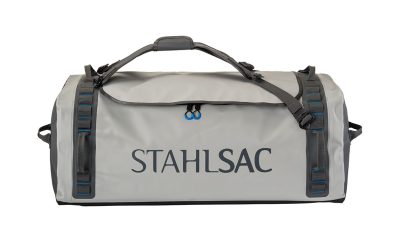Marine Life & Conservation
Japanese whaling ship rams Sea Shepherd boat in the South Pole after whale slaughter – watch video
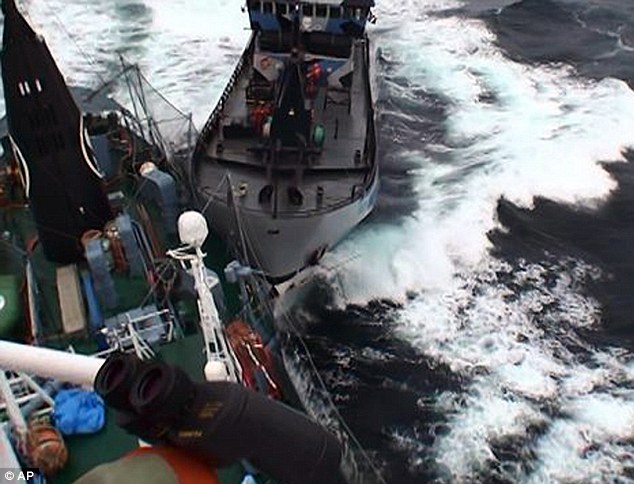
A Japanese harpoon whaling ship has rammed a conservationist protestors’ vessel in dramatic scenes in icy seas off Antarctica.
Video released by anti-whaling organisation, Sea Shepherd, shows the Japanese ship the Yushin Maru 2 crashing into the bow of the Bob Barker last week in the Southern Ocean off the South Pole.
Sea Shepherd claims the collision was deliberate and part of a sustained attack by three whaling ships on the protestors.
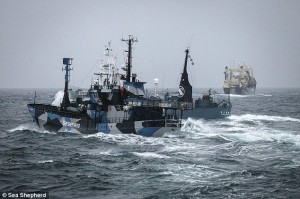 The Sea Shepherd boats, the Bob Barker and the Steve Irwin, were patrolling off Antarctica in the RossSea, the most pristine marine ecosystem on earth in which a high concentration of marine wildlife has remained mostly free from pollution, mining and fishing.
The Sea Shepherd boats, the Bob Barker and the Steve Irwin, were patrolling off Antarctica in the RossSea, the most pristine marine ecosystem on earth in which a high concentration of marine wildlife has remained mostly free from pollution, mining and fishing.
Known as “the last ocean”, the RossSea teems with large predatory fish, whales, seals and penguins.
The Sea Shepherd vessels had sailed to the Ross Sea to interfere with a Japanese whaling fleet comprising the Yushin Maru, Yushin Maru 2, Yushin Maru 3 and the world’s only whaling factory ship, the Nisshin Maru.
Sea Shepherd claims the Japanese ships launched a sustained eight hour attack from around 1am Australian Eastern Daylight Time (AEDT) on Sunday 2nd February.
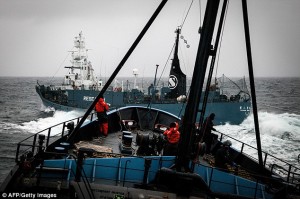 Sea Shepherd said its ships had positioned themselves off the Nisshin Maru’s slipway to block the harpoon vessels from loading the corpses of whales they had caught onto the factory ship.
Sea Shepherd said its ships had positioned themselves off the Nisshin Maru’s slipway to block the harpoon vessels from loading the corpses of whales they had caught onto the factory ship.
The Nisshin Maru is chartered by Japan’s Institute of Cetacean Research (ICR), which claims to be a nonprofit research organization of whales and dolphins, but which Sea Shepherd and Greenpeace say is just a Japanese Government-funded operation for slaughtering whales for profit.
In the attack, which continued until 9am, the harpoon vessels overtook the Sea Shepherd ships, crossing their bows and coming within three to five metres in numerous “dangerous manoeuvres”, Sea Shepherd claimed.
It said the Yushin Maru 3 struck the Bob Barker and quoted the ship’s captain, Peter Hammarstedt, and Siddarth Chakravarty of the Steve Irwin saying the two ships on several occasions had to steer out of the harpoon whalers’ paths, narrowly avoiding potential collisions.
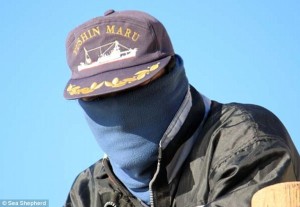 ‘The whaling vessels also made consecutive attempts to foul the propellers of the Sea Shepherd ships by dragging steel cable across the bow of the conservation ships,’ Sea Shepherd said.
‘The whaling vessels also made consecutive attempts to foul the propellers of the Sea Shepherd ships by dragging steel cable across the bow of the conservation ships,’ Sea Shepherd said.
Greenpeace claims the Nisshin Maru has twice rammed its vessel, the Arctic Sunrise, although the Institute for Cetacean Research contested Greenpeace was to blame.
ICR says on its website Greenpeace and Sea Shepherd engage in dangerous ‘sabotage’ which endangers life at sea.
‘Sea Shepherd group, one of several Greenpeace offshoots, joined the interference against Japan’s whale research and, imitating Greenpeace methods such as illegal boarding and ramming of research vessels, started to use increasingly dangerous and violent sabotage methods which include entangling devices (propeller foulers), throwing and shooting of chemical-containing projectiles, smoke bombs and incendiary devices,’ ICR said.
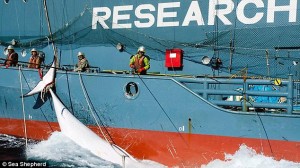 ‘Such dangerous actions by these groups are not peaceful protest but unforgivable acts akin to terrorism that threaten human life at sea.
‘Such dangerous actions by these groups are not peaceful protest but unforgivable acts akin to terrorism that threaten human life at sea.
‘Over and over again we have strongly condemned the harassment and sabotage actions by these groups and demand again that they refrain from further spreading violence under pretext of protecting whales.’
Sea Shepherd’s team of volunteers from around the world has photographed the ICR’s harpooning of whales, and slaughter of dolphins in the Japanese port of Taiji.
Australian Alana West told of the scene at Taiji last year, when the Japanese team herded a pod of striped dolphins into Taiji Cove and how she could hear ‘the distress cries of the dying pod members’.
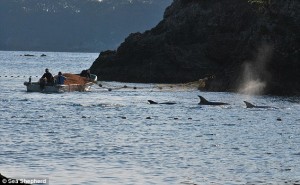 ‘Although the noise and confusion of the killing must have been terrifying for these dolphins, they did not swim to the other end of the Cove, as they so wanted to be with their pod members who were in fear and pain and were taking their last breaths,’ Alana said.
‘Although the noise and confusion of the killing must have been terrifying for these dolphins, they did not swim to the other end of the Cove, as they so wanted to be with their pod members who were in fear and pain and were taking their last breaths,’ Alana said.
‘It was incredibly harrowing to witness.’
Source: www.dailymail.co.uk
Here is the video:
[youtube id=”7QCKpq15qTI” width=”100%” height=”400px”]
Blogs
The Ocean Cleanup Breaks 10,000,000 KG Barrier

The Ocean Cleanup, the global non-profit project, has removed a verified all-time total of ten million kilograms (22 million lbs.) of trash from oceans and rivers around the world – approximately the same weight as the Eiffel Tower.
To complete its mission of ridding the oceans of plastic, The Ocean Cleanup uses a dual strategy: cleaning up the Great Pacific Garbage Patch (GPGP) to remove the plastic already afloat in the oceans, while stopping the flow of plastic from the world’s most polluting rivers.
Through cleaning operations in the GPGP and in rivers in eight countries, the cumulative total of trash removed has now surpassed ten million kilograms. This milestone demonstrates the acceleration of The Ocean Cleanup’s impact, while underlining the astonishing scale of the plastic pollution problem and the need for continued support and action.
While encouraging for the mission, this milestone is only a staging point: millions more tons of plastic still pollute our oceans and The Ocean Cleanup intends to continue learning, improving and innovating to solve this global catastrophe.
This announcement comes as governments from around the world meet to continue negotiations to develop a new legally binding instrument to end plastic pollution at INC4 in Ottawa, Canada. Representatives of The Ocean Cleanup will be in attendance and the organization will be urging decision-makers to collaborate towards a comprehensive and ambitious global treaty which addresses plastic at all stages of its life cycle and in all marine environments worldwide, including in areas beyond national jurisdiction.
It is encouraging to see that the need for remediation is reflected in the various options for potential treaty provisions. It is essential that the final treaty contains clear targets for the remediation of legacy plastic pollution, and reduction of riverine plastic emissions.
Tackling plastic pollution requires innovative and impactful solutions. The treaty should therefore incentivize the innovation ecosystem by fostering innovations that make maximal use of data, technology and scientific knowledge – such as those designed and deployed by The Ocean Cleanup.
‘After many tough years of trial and error, it’s amazing to see our work is starting to pay off – and I am proud of the team who has brought us to this point.’ said Boyan Slat, Founder and CEO of The Ocean Cleanup. ‘While we still have a long way to go, our recent successes fill us with renewed confidence that the oceans can be cleaned.’
The Ocean Cleanup was founded in 2013 and captured its first plastic in 2019, with the first confirmed catch in the GPGP coming soon after the deployment of Interceptor 001 in Jakarta, Indonesia. After surpassing one million kilograms of trash removed in early 2022, the non-profit project has since progressed to the third iteration of its GPGP cleaning solution, known as System 03, and a network of Interceptors currently covering rivers in eight countries, with more deployments set for 2024.
About The Ocean Cleanup
The Ocean Cleanup is an international non-profit organization that develops and scales technologies to rid the world’s oceans of plastic. They aim to achieve this goal through a dual strategy: stemming the inflow via rivers and cleaning up the legacy plastic that has already accumulated in the ocean. For the latter, The Ocean Cleanup develops large-scale systems to efficiently concentrate the plastic for periodic removal. This plastic is tracked and traced through DNV’s chain of custody model to certify claims of origin when recycling it into new products. To curb the tide via rivers, The Ocean Cleanup has developed Interceptor™ solutions to halt and extract riverine plastic before it reaches the ocean. Founded in 2013 by Boyan Slat, The Ocean Cleanup now employs a broadly multi-disciplined team of approximately 140. The foundation is headquartered in Rotterdam, the Netherlands.
For more information, visit: theoceancleanup.com and follow @theoceancleanup on social media.
Marine Life & Conservation
Steve Backshall to headline Shark Trust’s flagship event: For the Love of Sharks

Join a host of amazing, shark loving, speakers including Steve Backshall and the Shark Trust team for an evening celebrating shark conservation at the Royal Geographical Society in London this November.
Date: 29th November 2024
Time: 6-10pm
Location: Royal Geographical Society, London
Tickets: https://www.sharktrust.org/Event/flos24
The event will be a celebration of all things shark. Those lucky enough to get hold of tickets will hear from engaging guest speakers with a passion for sharks.
The line-up includes (*subject to change if unforeseen circumstances arise)
Steve Backshall: One of television’s busiest presenters, BAFTA award-winning wildlife expert Steve has been passionate about the wild world ever since he was young.
Steve’s impressive TV career has taken him all around the world, investigating a wide array of species and environments. Steve has filmed over 100 hours of children’s wildlife programmes with the BAFTA award winning Deadly 60 franchise and recently, with Sky Nature, for his new series ‘Whale with Steve Backshall’. He has been a patron for the Shark Trust for 10 years.
Simon Rogerson: is a photojournalist specialising in natural history, diving and the sea.
He is editor of SCUBA magazine, the official journal of the British Sub-Aqua Club. Simon started his career as a crime reporter but gravitated towards his ‘less depressing’ interest in underwater exploration, joining the staff of DIVE magazine in 1999. In 2005 he was named ‘Editor of the Year’ in the PPA’s Independent Publishing Awards. Simon also works as a freelance writer, contributing frequently to the Sunday Times and Telegraph, in addition to BBC Wildlife, Esquire, and a host of international diving magazines. He is the author of a book, Dive Red Sea, published by Ultimate Sports. Now based in Berkshire, Simon has been a Patron of the Shark Trust for 20 years.
More speakers to be announced soon. Head to the Shark Trust website to learn more.
The evening will also allow guests the final chance to see the Oceanic 31, shark art exhibition. Some of the artwork will be auctioned/raffled at the event, while the rest will be auctioned online to raise money for the Shark Trust Oceanic Programme.
For the Love of Sharks is an evening with something for everyone who is interested and fascinated by sharks. Join the Shark Trust, their Patrons, Trustees and Staff, along with a host of supporters for this celebration of shark conservation.
For more information or to buy a ticket: https://www.sharktrust.org/Event/flos24
-

 News3 months ago
News3 months agoCapturing Critters in Lembeh Underwater Photography Workshop 2024: Event Roundup
-

 Marine Life & Conservation Blogs3 months ago
Marine Life & Conservation Blogs3 months agoCreature Feature: Swell Sharks
-

 Blogs2 months ago
Blogs2 months agoMurex Resorts: Passport to Paradise!
-

 Gear Reviews3 weeks ago
Gear Reviews3 weeks agoGEAR REVIEW – Revolutionising Diving Comfort: The Sharkskin T2 Chillproof Suit
-

 Blogs2 months ago
Blogs2 months agoDiver Discovering Whale Skeletons Beneath Ice Judged World’s Best Underwater Photograph
-

 Gear Reviews3 months ago
Gear Reviews3 months agoGear Review: Oceanic+ Dive Housing for iPhone
-

 News2 months ago
News2 months agoPADI Teams Up with Wellness Brand Neuro to Drive Ocean Change and Create a Blue State of Mind
-

 Marine Life & Conservation2 months ago
Marine Life & Conservation2 months agoSave the Manatee Club launches brand new webcams at Silver Springs State Park, Florida



